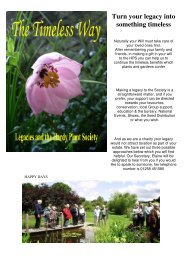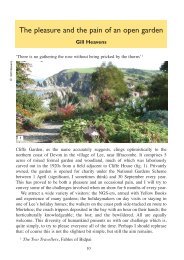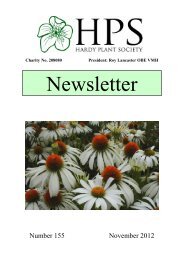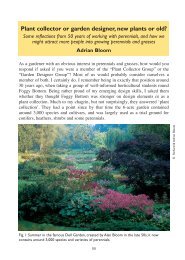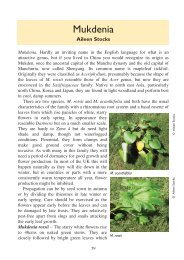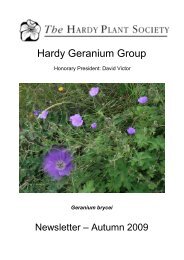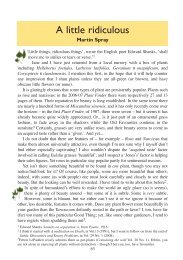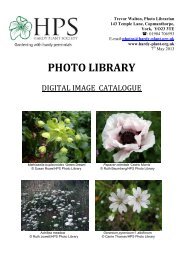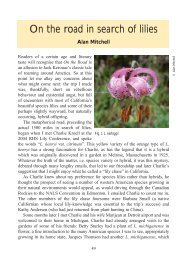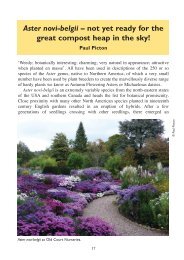You also want an ePaper? Increase the reach of your titles
YUMPU automatically turns print PDFs into web optimized ePapers that Google loves.
<strong>Phormium</strong> Phun<br />
Paul Ingleton<br />
<strong>Phormium</strong>s have been in and out of fashion<br />
over the years and are now very much ‘in’<br />
with the grass-garden fad. Certainly many<br />
<strong>Hardy</strong> <strong>Plant</strong>ers will have the odd specimen or<br />
two. They tend to grow large with age. Very<br />
large. I find myself giving a drastic cut-down<br />
every few years to my twenty-year-old plant<br />
and am left with a huge pile of unshreddable<br />
and uncompostable leaves. It goes against the<br />
grain to just dump them in the dustbin (even<br />
if they would all fit in) – so, what to do.<br />
The alternative name for these plants is<br />
New Zealand flax, and therein lies a clue as<br />
to their use. I’d read somewhere that they<br />
were once tried as a commercial crop for<br />
rope making (for some reason it didn’t take<br />
off) and I have found the fibres to be Fig. 1<br />
amazingly strong and versatile. For years I<br />
have used the dried leaves for tying-up jobs<br />
around the garden: you just strip off a strand<br />
off the required thickness and cut to length.<br />
I keep a dried leaf base, cut to about a foot<br />
length, in my pocket and just strip off<br />
strands when I need to tie anything. I<br />
haven’t bought twine for ages and the<br />
phormium eventually rots away if left long<br />
enough (especially useful for espalier fruit<br />
trees, etc.).<br />
Fig. 2<br />
I also used it to make bamboo climbing<br />
frames (fig.1) for beans, pot plants, etc. – bamboo sticks (however many<br />
required), cut from the garden of course, bound at the top with phormium leaves.<br />
The phormium stays the original leaf colour for a while and then dries to a<br />
pleasant brown. Make a big wound-round-and-round knot for ornamental effect if<br />
you like; after all, there’s no shortage of materials!<br />
53<br />
© Paul Ingelton<br />
© Paul Ingelton
© Paul Ingelton<br />
© Paul Ingelton<br />
Fig. 3<br />
Fig. 4<br />
One year I played around with weaving<br />
the leaves to make linings for my mangertype<br />
wall baskets (fig. 2). I just used simple<br />
basket weave with the freshly cut leaves.<br />
They lasted about five years! By then it<br />
was chopping-time again on an even<br />
grander scale. The new basket liners didn’t<br />
make much of a dent in the enormous pile.<br />
An idea had been brewing for a while<br />
that my shed needed a more ethnic look to<br />
blend in with the planting – the felt roofing<br />
looked awful – so I decided to try weaving<br />
a large mat to cover it. I have found that<br />
weaving the leaves whilst still green is<br />
easiest; once they dry out and become stiff<br />
it is impossible to bend them sharply<br />
enough for basket-weave. However, the<br />
roof-sized mat that resulted was very<br />
heavy – too heavy to put on the shed. More<br />
by accident and laziness than design, I just<br />
left the mat on a paved area for a few<br />
weeks whilst I pondered what to do with it.<br />
Lo and behold, the mat dried out<br />
dramatically to make a light, easily moved<br />
roof covering, simple to fix with cup-hooks<br />
screwed into the roof (fig. 3).<br />
I even tried weaving a covering for<br />
some aluminium garden chairs, which I<br />
disliked because they were either very cold<br />
to sit on or scorching hot. I wouldn’t say<br />
the result looked elegant but it did have the<br />
effect of making the chairs usable (fig. 4).<br />
I don’t know if anyone else has found<br />
novel uses for this or any other garden<br />
‘produce’, but I had fun and also felt<br />
virtuously green by recycling what would<br />
have gone to landfill.<br />
Paul Ingleton’s earliest gardening memory is helping grandma plant potatoes,<br />
and as a child he once had a huge of assorted tulips as a Christmas present. He<br />
has been gardening ever since.<br />
54



